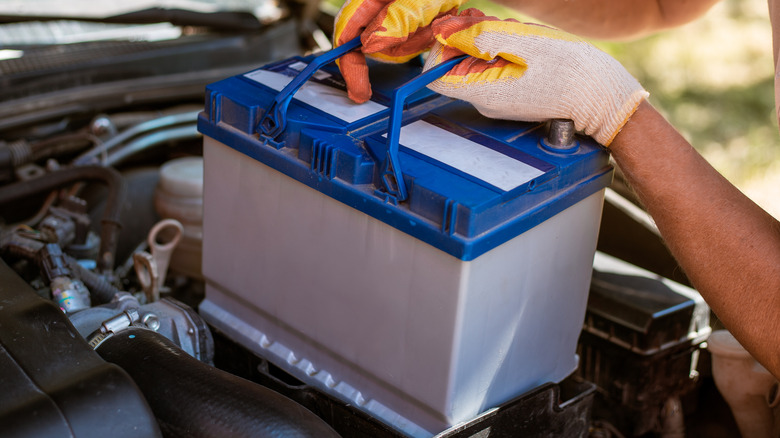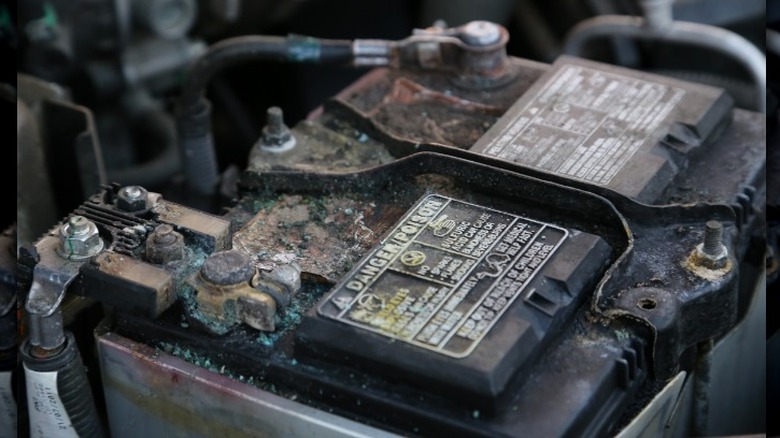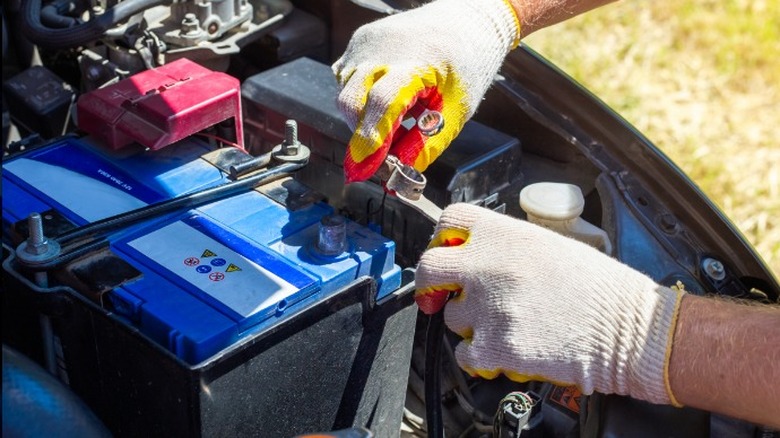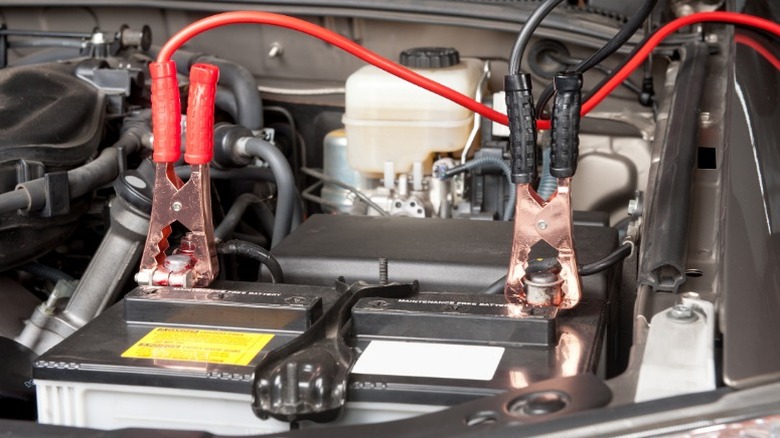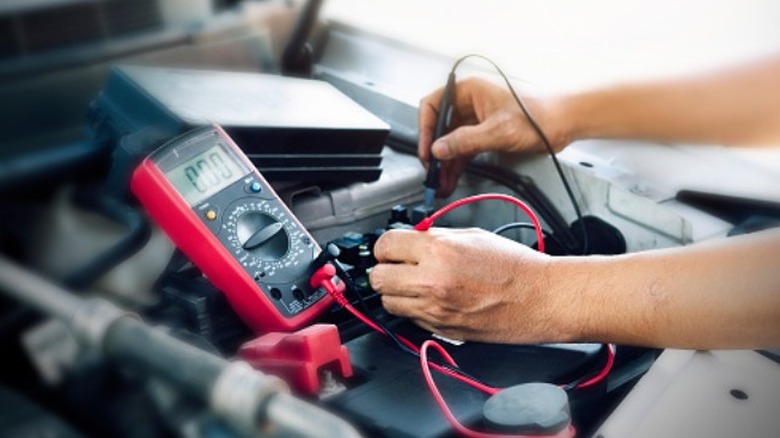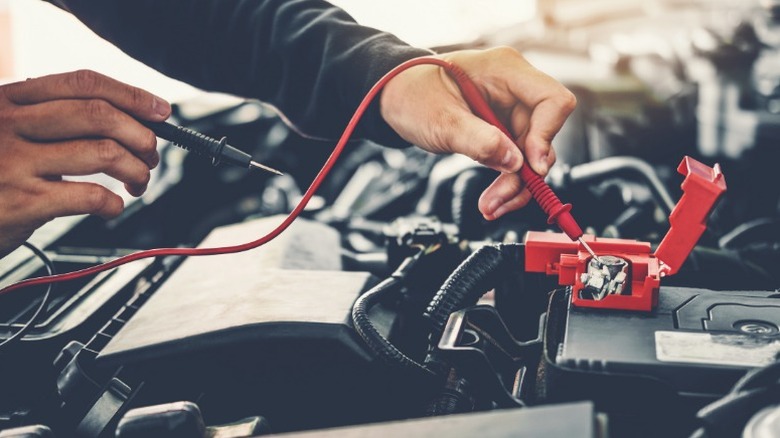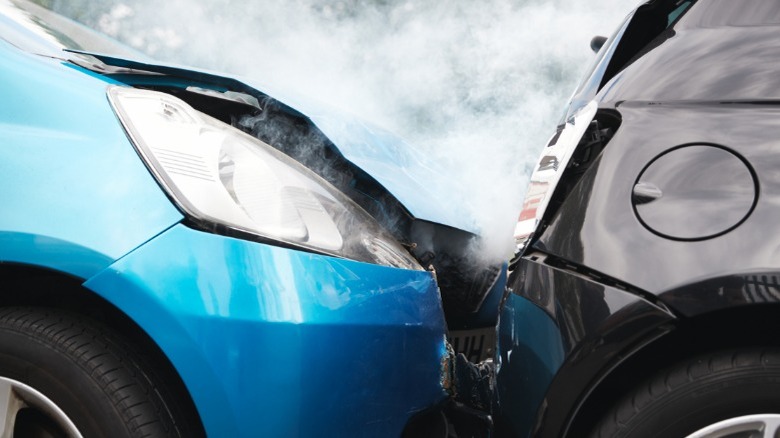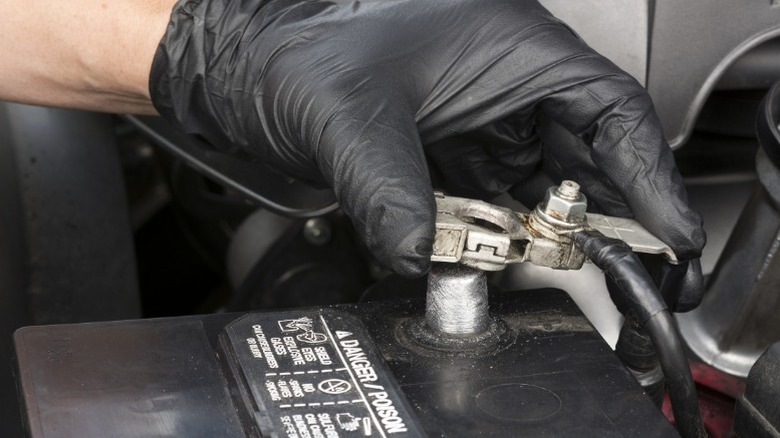8 Reasons Your Car Battery Keeps Dying (And How To Prevent Them)
The modern automobile is an amazing piece of technology that most of us rely on every day for our transportation needs but often take for granted. Of course, when it won't start our lives are interrupted in a big way. Perhaps the most common problem any of us will experience with our car has a dead battery. Thankfully, this maddening issue is usually overcome with a quick jumpstart. While the problem can be solved pretty easily, it is still important to know that there is always a reason for a dead battery, and troubleshooting the issue is paramount to avoid further interruptions.
Charging systems on cars are relatively simple and are comprised of a few key elements. Attached to the engine is an alternator. It is driven by the engine with a belt that turns a stator inside a rectifier, creating an alternating current. A regulator, which is almost always part of the alternator on modern cars, then converts the electricity into direct current to feed power to the battery. All the car's electrical systems draw power from the battery while the alternator continuously charges it. If everything is operating normally, this continues for as long as the engine is running.
Most automotive batteries are lead-acid type and are generally very robust, lasting four years on average. Any interruption in this cycle can lead to a dead battery and a frustrated car owner. So, with the basics covered, let's look at eight reasons your battery is dying and how to prevent them.
The battery is old
Battery technology is very old, and the technology that goes into manufacturing them has advanced greatly over the years, meaning the batteries we use today are about as good as they can get. Your car most likely has a lead-acid battery, although some more expensive alternatives exist. Batteries contain acid that sits in between (mostly) lead plates, facilitating the flow of electrons that is electricity. A car battery consists of several cells of acid between lead plates each with a nominal voltage, and the voltage of all the cells adds up to about 12.8 volts when fully charged. Over time, sulfur deposits form on the plates and can eventually build up to the point that it impedes electrical flow from one plate to another. When this happens, one or more of the cells can go dead, reducing the overall voltage and capacity to operate the starter motor.
While this explanation is more than what you really need to know what to do, it does explain why your battery may just be too old to keep working. Most auto parts stores have battery testers that test the voltage under an electrical load to simulate how it performs while being used, for example, to start a car. This is the best way to determine if the battery is bad, as a simple test of the voltage with a multimeter may show a full charge on a weak battery. So, if your car needs regular jumpstarts, take the car or just the battery to a parts store and have them test it. There should not be a charge for doing so.
Wrong size battery
For anyone driving a car they bought new or who has had a battery replaced by a competent and reputable repair shop, this probably does not apply. However, if you bought your car used or replaced the battery yourself without first checking to be sure you bought the battery suggested by the manufacturer for your vehicle, it is possible that you could have the wrong size of battery installed.
If your battery is too small, it will probably work just fine, for a time. You may have already noticed that the engine sounds like it cranks slowly but eventually manages to start up anyway. You may get away with this for a while, but it will eventually end in battery failure. The greatest amount of demand put on a car battery occurs when starting the car. It takes a tremendous amount of electricity to turn a motor fast enough to get the engine firing. Larger engines, such as a V8, require more power than a 4-cylinder, and a high-compression diesel engine also requires more energy to get going.
Thankfully, this is a simple fix. You will need to have the battery tested first. If it is found to be bad as well as too small for your car, find one that matches the manufacturers' recommendation and you should be good to go — assuming another problem is not looming in the shadows.
Extreme cold weather
This really only pertains to people living in higher latitudes, especially places like the Dakotas, Canada, or Norway. People throughout most of the world are not likely to have much of an issue, even on the coldest days. However, extremely cold temperatures can have an impact on your battery life.
Your typical car battery in freezing weather drops about 20% in capacity, while it reaches a 50% drop in -22 degrees Fahrenheit. These conditions put an extra strain on your battery, and that can cause a chain reaction of events that lead to a car that won't start. Due to the reduced capacity, the starter motor has to work extra hard to get the engine going, causing even greater demand on the battery, and all of this can reduce the long-term capacity of the battery. This is compounded by the tendency of oil to thicken in cold weather, creating even more friction the starter must overcome to get the engine going.
For the most part, people who live in very cold climates likely know how to deal with these issues already. You can't do anything to change the laws of physics, but you can do some things to keep your battery from being overworked. Key among them is an engine block heater that keeps the engine warm and the battery warmer. Otherwise, the best thing to do is to make sure your car is in top running condition and checked out by a professional regularly.
Charging system malfunction
A battery with a full charge sits at 12.8 volts. This will start the car and keep everything running, but to ensure it maintains this voltage, it must be charged with additional voltage. That is why the average car charges the battery with 13.6 volts, although some may be higher. This allows the battery to remain at a full charge while components such as the blower motor and headlights have enough power to function.
If your alternator is not producing a steady 13.6 volts, your battery will eventually die. It might take some time but it will get there, especially if driving at night with the air conditioner on full blast. The most common point of failure with a charging system is the alternator. Sometimes these can quit working without warning while other times they will show some symptoms before quitting. If you are lucky, a problem with the accessory drive belt on the engine is causing a low charge rate and can be fixed inexpensively. Otherwise, alternators for late-model cars can cost hundreds of dollars. Also, most new vehicles have the ECU controlling the charging system, and malfunctions of sensors or controllers can also cause issues with the charging system, and these problems require a more extensive diagnosis.
Fortunately, the same kind of test that can be done to your battery can also be done to your alternator at most parts stores for free. They will try to sell you a replacement part, but that should only be done if you know what you are doing. Otherwise, take it to a professional, as replacing an alternator can be a tough job to complete.
Power drain
Modern cars are full of electronics. When a particular system malfunctions, it can create a small but constant electrical draw on the battery. For a technician, these problems can be among the most difficult and infuriating to solve. Thankfully, they are relatively rare.
Sensitive electronics control almost everything in your car. Engine management and interior conveniences like the touch screen and digital gauges are run by computer modules, as are all of the interior lights, windows, and locks. When all of these are working properly, your car and battery operate as intended. When something is not, it can spell trouble, and corroded or damaged switches can make things worse. These issues can cause what is called a parasitic draw, which happens when something causes electrical current to flow through the circuit, either constantly or intermittently. An electrical contact that has developed corrosion can cause this, as can a malfunction in a circuit panel or microprocessor. Furthermore, the rate of drain can vary, resulting in a dead battery that occurs after weeks or hours.
If the charging system and battery check out, you need to make sure that nothing is obviously staying on, such as an interior light that remains illuminated overnight. If this doesn't reveal the problem, you will need to have a skilled technician look at your car. Unfortunately, this can be time-consuming and expensive — although, if you are lucky, a simple scan of the computer may show the fault immediately.
Not driving enough
Most people probably think they have to drive too much. This will not affect them. However, as strange as it may sound, not driving your car can cause your battery to go dead. This issue primarily applies to those who own multiple vehicles, often as part of a collection of luxury and supercars. Still, it can affect others who own a car but rarely need to drive it.
This problem affects the newest cars almost exclusively, as it relates to the electronics of the car. New vehicles have dozens of convenience features and security measures installed by the factory. To keep systems either monitored or at the ready, the ECU draws a low level of power from the battery to continue doing its job. This is particularly prevalent among new luxury cars like those from BMW. The power draw is minimal and won't affect many users, but left long enough parked in a garage, your new M3 just might go dead. This is also called a parasitic drain, and it can even affect some older cars just by maintaining the time on the clock.
If you own a car that does not see a lot of time on the road, preventing parasitic drain is easy. If the car is parked with available electricity, all you need is a trickle charger, which is a small battery charger that only puts out enough power to maintain a full charge. They often come with a plug that can be permanently wired to the battery to make for a simple connection any time you want to take a drive. Otherwise, battery disconnect switches are available that connect to the power cable of the battery and cut off all power to the car when parked.
Physical damage
A battery can incur physical damage from a few sources and should be replaced immediately regardless of how it was damaged.
Damage can occur from a collision of some kind, even if it was relatively mild and the car is perfectly drivable. If the impact location is near the battery, it can crack the case, allowing acid to leak. Battery acid is highly caustic and will eat through metal and burn the skin. Also, if the battery is not locked firmly into place, it can move while the car is in motion and get tossed around enough to cause cracks in the casing. Furthermore, if your charging system malfunctions and overcharges the battery, it can swell with gas, causing leaks from a split case.
If you are experiencing starting troubles, this issue is one of the easiest to diagnose. Cracks and other damage should be obvious with a brief visual inspection. If you see cracks or notice fluids leaking from the battery, get it replaced immediately. If you choose to do it yourself, make sure you wear protective gloves to prevent an acid burn to your skin.
Faulty terminal connections
This is probably the most common reason for low or dead batteries. Since car batteries handle a significant amount of power, the cables and terminals that connect to the car are large and require a solid connection.
Corrosion of the terminals occurs between the contact points of the copper of the electrical cables and the lead of the battery terminals. The cause is usually hydrogen gas emitted by the battery under normal operation coming into contact with the metals, creating a chemical reaction. Also, a leaking battery can cause corrosion when the acid from the battery comes into contact with the terminals. The corrosion results in a lower ability for the connection to allow current to flow, as electricity cannot pass through the corrosion. This will result in the battery undercharging and eventually going dead altogether.
Additionally, loose terminals can have the same effect as corroded terminals. Either way, it is an easy repair on most cars. Terminals can be cleaned or replaced on many models at a low cost, and the job can be done by most entry-level mechanics. A simple visual inspection will usually be enough to diagnose the problem.
